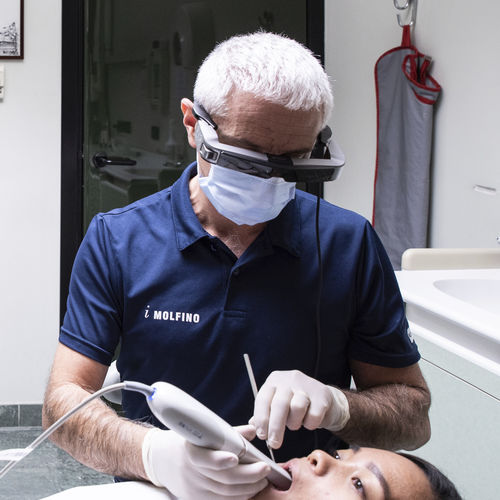
#Product Trends
AR in Dentistry – Can you see where this is going?
Ignore the hype – Moverio is a genuinely useful tool
We’ve all seen the goofy confections. First-generation Microsoft Hololens, Google Glass and Snapchat Spectacles to name three of the best known. But working quietly away behind the scenes, Japanese owned digital imaging specialist, Epson, has produced a sensibly priced, sensibly designed Augmented Reality platform that actually WORKS. Not only that, but their partner programme is producing some genuinely useful applications.
We caught-up with Epson Moverio partners D.T.U.Srl at the London Dentistry Show and spoke to Valter Scaioni about his product.
“We’ve worked in the dental industry for many years,” he says. “The Epson Moverio BT350 provides an excellent platform for visualisation applications.”
“But it also has great communications capabilities, connecting to computers in the surgery via WiFi – so no additional training wires. We’ve used it to solve a couple of problems that might seem small to the uninitiated, but that are actually very important in dentistry.”
What does it do?
D.T.U. has brought two applications to market for dentistry. And at first glance, like the Epson Moverio BT350 platform they run on, they don’t appear spectacular. But that’s sort of the point – they aren’t built by a marketing department to grab headlines. They are built by an established ‘digital dentistry’ company to fulfil a need.
Scanning made simple
The first application is all about image capture, and anyone who has used an intra-oral 3D-scanner will identify with it. Normally, when creating a scan, you are continuously looking at the patient’s mouth and turning away to a monitor to see the model being built during the scan. This slows the process and creates opportunities for errors.
What D.T.U.’s app does is to project an image of the model directly onto Moverio’s lens. As these are in-line with your normal vision, checking the model requires only a tiny eye movement and a slight change of focus. The result is better quality scanning completed quicker, with the added advantage for the dentist of keeping the working posture he/she is used to during the procedure.
Enhanced patient comfort
D.T.U.’s second application is for patient comfort and makes use of the Moverio’s communications capabilities.
Imagine your patient, in your chair. You’ve just spent what seems like forever setting up a rubber damn and swabs for your procedure, and they suddenly go pink, then red, and finally explode in a coughing fit. Not great for you, your patient, or the nurse who has to clear-up the resulting mess. It might have been good to have had some warning. And that’s exactly what Moverio does.
Wearing a Moverio headset and holding the simple hand controller, the patient is able to view a menu and select options. Meanwhile, Moverio is talking to a Blue-tooth smart speaker in the surgery. The patient can choose what music to listen to, helping make them more relaxed.
They can also select from a number of pre-defined messages that also play through the smart speaker. That means they can let you know that they are uncomfortable, that they need a drink, that they think they are going to cough or ask you how long you’re going to be.
You might at first think that’s trivial. But put yourself in the dentist’s chair for one moment. Wouldn’t you like to be able to tell your own dentist that you’re feeling discomfort or you’re worried you’ll miss your bus?
This might not be a worthy investment for every patient. But what about nervous patients, disabled patients and other special needs use cases? It could definitely help better manage some of these.
Where is this going?
D.T.U. is currently expanding the range of applications it offers for Moverio, such as showing animations of procedures or other video content to patients, and visualisation applications for dentists. As Valter Scaioni says; “I believe the DTU – SVG product can be further improved, especially the entertainment part. We offer complementary active accessories, such as Bluetooth speakers and audio headphones to enable this. For example, it is possible to use the device to play videos that show techniques performed by the dental clinic (implantology, bleaching, surgery, etc.), and also the possibility of connecting the glasses to the internet using WiFi to access network contents, such as Netflix, Youtube, etc. or entertainment for children (cartoons).”







